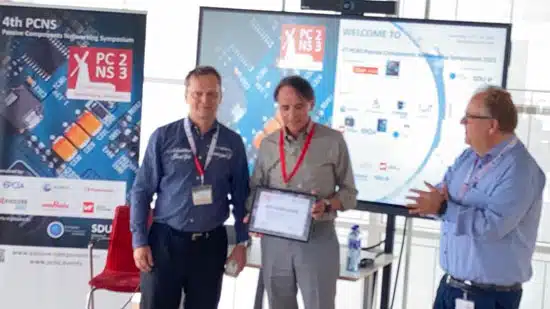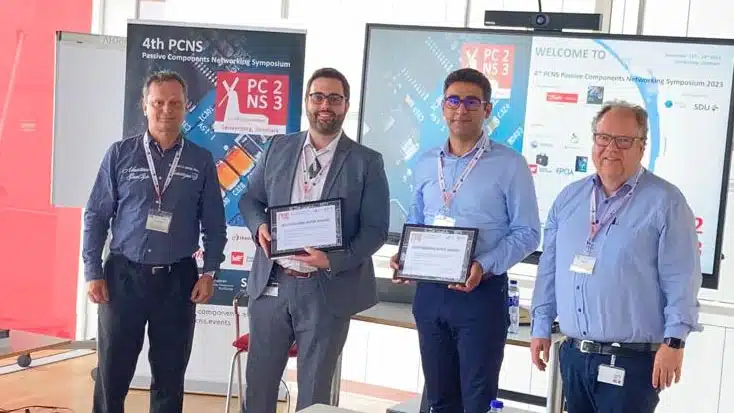Attendees of the 4th PCNS Passive Components Networking Symposium that took place on 10-14th September 2023 in Sønderborg Denmark valued high technical level of the conference, inter-change of knowledge between semiconductors, passive components and whole supply chain.
4th PCNS organized by EPCI and hosted by SDU University of Southern Denmark, Sønderborg, as live event was attended by 70 attendees from 13 countries including Europe, USA, Japan and Korea.
The conference theme “New Passive Components Technologies for Efficient Power Conversion” were elaborated in conference paper selection, keynotes, workshop and hot topic panel discussion topics.
Twenty seven full technical papers were presented during two and half PCNS event days covering wide range of passive components including capacitors, resistors, inductors, integrated passives or smart textiles.
PCNS Technical Programme Committee (TPC) awarded The Best Paper and two Outstanding Papers with prize award and certifications out of the selected nomination. The selection is based entirely on the material submitted – abstract, full paper and presentation.
4TH PCNS AWARDS and NOMINATION
BEST PAPER
Abstract
High Energy Density NanoLamTM Capacitors for Use in Spacecraft Power Processing Units
Speaker: Angelo Yializis Ph.D; Polycharge America Inc., USA
High Energy Density NanoLamTM Capacitors for Use in Spacecraft Power Processing Units
Speaker: Angelo Yializis Ph.D; Polycharge America Inc., USA
Two of the largest and most critical components in virtually all Power Processing Units of spacecraft, probes, and landers, are energy buffer and DC-link capacitors, used to minimize ripple current, voltage fluctuations, and transient suppression. In addition to conventional high-temperature requirements, missions to planetary bodies that are distant from the sun, as well as lunar regions that are permanently shadowed, require electrical components with low-temperature survivability and predictable and stable functionality at temperatures as low as -240°C.
Current capacitor technologies have severe performance limitations, especially when operated at cryogenic temperatures with exposure to cosmic radiation, as well as radiation internal to the spacecraft. NanoLamTM capacitors, produced using a nanolaminate composite, formed using 1-2Mrad of ionizing Beta radiation, have excellent stability of dielectric properties over a wide temperature range, superior energy density and specific energy, and resistance to degradation when exposed to ionizing radiation. In this work, electrical measurements of key dielectric parameters are performed as a function of temperature in the range of -269°C to +145°C.
NanoLamTM capacitors are tested both in the form of individual 3000-layer capacitor elements and as capacitor blocks, comprising multiple capacitor elements with ratings of 750uF/50V and 4.4mF/50V. The effects of highly accelerated voltage stress of 75V to 150V and temperatures as high as 145°C have been analyzed and lifetime to parametric failure is approximated using a Weibull log-linear model.
Outstanding Paper
Abstract
Quality Assessment and Lifetime Prediction of Base Metal Electrode Multilayer Ceramic Capacitors: Challenges and Opportunities
Speaker: Pedram Yousefian; PhD Candidate, Center for Dielectrics and Piezoelectrics, Materials Research Institute, The Pennsylvania State University, USA
Abstract
Quality Assessment and Lifetime Prediction of Base Metal Electrode Multilayer Ceramic Capacitors: Challenges and Opportunities
Speaker: Pedram Yousefian; PhD Candidate, Center for Dielectrics and Piezoelectrics, Materials Research Institute, The Pennsylvania State University, USA
Base metal electrode (BME) multilayer ceramic capacitors (MLCCs) are widely used in aerospace, medical, military, and communication applications, emphasizing the need for high reliability. The ongoing advancements in BaTiO3-based MLCC technology have facilitated further miniaturization and improved capacitive volumetric density for both low and high voltage devices. However, concerns persist regarding infant mortality failures and long-term reliability under higher fields and temperatures. To address these concerns, a comprehensive understanding of the mechanisms underlying insulation resistance degradation is crucial. Furthermore, there is a need to develop effective screening procedures during MLCC production and improve the accuracy of mean time to failure (MTTF) predictions.
This article reviewing our findings on the effect of the burn-in test, a common quality control process, on the dynamics of oxygen vacancies within BME MLCCs. These findings reveal the burn-in test has a negative impact on the lifetime and reliability of BME MLCCS. Moreover, we discuss the limitations of existing lifetime prediction models for BME MLCCs and highlight the need for improved MTTF predictions by employing physics-based machine learning model to overcome the existinging models limitations. We also discuss the new physical-based machine learning model that has been developed. While data limitations remain a challenge, the physics-based machine learning approach offers promising results for MTTF prediction in MLCCs, contributing to improved lifetime predictions. Furthermore, the article acknowledges the limitations of relying solely on MTTF to predict MLCCs’ lifetime and emphasizes the importance of developing comprehensive prediction models that predict the entire distribution of failures.
Outstanding Paper
Abstract
Layer-by-layer printing: how we fabricate the next generation of nanocomposite capacitors for more efficient power electronics
Speaker: William Greenbank; University of Southern Denmark
yer-by-layer printing: how we fabricate the next generation of nanocomposite capacitors for more efficient power electronics
Speaker: William Greenbank; University of Southern Denmark
Electricity generation accounts for 47% of all new carbon emissions because electricity production is expected to increase by 80% by 2040 – a significant portion from fossil fuel sources. It is therefore necessary to both kerb rising demand for energy and increase renewable energy’s share of electricity generation to have any realistic hope of reducing emissions long-term. More efficient power electronics can have an enormous impact on energy wastage. Capacitors are critical to the operation of power electronics, but often the weak link when it comes to efficiency improvements. This is particularly true for electric motors, which account for 40% of all global electricity consumption and this will only increase as electric vehicles become more prevalent. Reducing energy waste in motors requires that their drives are smaller and can tolerate higher temperatures while remaining highly reliable and stable at high voltages. However, existing dielectric materials cannot deliver a capacitor that meets all of these requirements.
Nanocomposite dielectrics are an increasingly important area of innovation in capacitor research as an avenue to improve capacitive energy density, electrical breakdown strength, and temperature stability of devices. In such devices, morphology control is critical in order to optimise electrical field distribution in the device and to prevent the clustering of nanoparticles lowering breakdown voltages. However, this is difficult to achieve with large-scale fabrication techniques, such as melt extrusion and stretching, as melt processing can induce clustering and offers few possibilities for fine structure control of length scales below 1 µm.
Layer-by-layer fabrication offers a potential bottom-up alternative whereby dielectrics are printed by successive depositions of ultra-thin layers of a room-temperature-stable polymer ink. This would allow fine thickness and morphology control and could easily be adapted to industrial-scale printing techniques, like roll-to-roll slot-die coating. Our work explores the potential of this technique by developing two polypropylene-based inks in industry-friendly solvents that are then used to fabricate capacitor devices. A gel ink was able to be used to deposit ultrathin (sub-200 nm) layers of mostly amorphous polypropylene with high reproducibility. Capacitors based on these polypropylene layers perform commensurate with commercial devices, exhibiting excellent self-clearing and breakdown performance. Successive depositions of the ink were also demonstrated, allowing the fabrication of devices with finely tuned thicknesses and capacitances, as well as nanocomposite capacitors. This demonstrates the viability of layer-by-layer dielectric printing and paves the way for commercial ultra-thin conformable polypropylene capacitors, multi-component sandwich nanocomposite capacitors, and multilayer polypropylene capacitors, as well as brand new possibilities in dielectrics research.
Nomination
Abstract
Unleashing the Power: Superior Properties of Fluorographene-Derived Materials for Energy Storage Applications
Speaker: Michal Otyepka; CATRIN, Palacký University Olomouc, Czech Republic
Unleashing the Power: Superior Properties of Fluorographene-Derived Materials for Energy Storage Applications
Speaker: Michal Otyepka; CATRIN, Palacký University Olomouc, Czech Republic
Graphene, its composites, and derivatives have been identified as promising materials for energy storage applications, especially in supercapacitor and battery electrode materials. However, the direct preparation of graphene derivatives from graphene is hindered by the high inertness of graphene. One possible solution to this challenge is the utilization of the fluorographene chemistry, which can be carried out under mild and controllable conditions. Furthermore, the chemistry of fluorographene benefits from an easily available pristine material, graphite fluoride, on the market. Various graphene derivatives have been prepared using fluorographene chemistry. These derivatives have shown promising properties as electrode materials for supercapacitors and batteries.
One of these derivatives is graphene acid (available at graphene-derivatives.com), which is produced through a two-step synthesis and bears ~12% of covalently grafted carboxyl groups on both sides. Graphene acid is a conductive (~25 S/m) and perfectly water-dispersible material, making it an excellent candidate for supercapacitor electrodes. Graphene acid has demonstrated a capacitance of ~100 F/g and high specific capacitance retention (>95%) after 60,000 C/D cycles at a current density of 3 A/g in a two-electrode cell system. The performance of graphene acid can be further improved by hybridizing it with a metal-organic framework (MOF) materials. A resulting hybrid material acts as an effective charge storing material with a capacitance of up to 650 F/g.
Another interesting class of supercapacitor electrode materials is nitrogen-doped graphene, which is obtained through the reduction of fluorographene by nitrogen-containing compounds. Another nitrogen-doped graphene with a high level of nitrogen doping, diamond-like bonds and an ultra-high mass density of 2.8 g/mL exhibits high volumetric energy (up to 200 Wh/L) and power density (up to 52 kW/L) [7]. Commercialization of this material (SC-GN3) is currently supported by EIC Transtion project (trans2Dchem.com).
Finally, the chemistry of fluorographene can also be used to conjugate graphene with polysulfide chains, leading to highly sulfur-doped graphene. This material exhibits very high full-cathode-mass capacity and rate capability, combined with superior cycling stability, making it an efficient cathode material for LiS batteries with a low shuttling effect.
Nomination
Abstract
Smart textile speaker
Speaker: Julie Hladikova and Jiri Navratil; University of West Bohemia, Pilsen, Czech Republic
Smart textile speaker
Speaker: Julie Hladikova and Jiri Navratil; University of West Bohemia, Pilsen, Czech Republic
Smart textiles or e-textiles are evolving part of electronics and bring new approaches and views for the electronics device itself. The materials and technologies such as conductive threads, ribbons, new contacting technologies and interconnecting with conventional electronics are crucial part of the development of new functional smart textiles garments. This abstract is focused on the development and testing of textile electroacoustic transducer (speaker).
A hybrid conductive thread is used for embroidering of the coil and small magnet is placed under it. When audio signal is played in the embroidered coil, interaction of the magnetic fields creates forces between magnet and coil and the textile itself works as a membrane of the speaker. The coil shape and size is optimized and the final pattern is embroidered to real textile products – a pillow and an elastic sport headband. The frequency characteristic of the tested patterns and of the textile products will be presented in the full paper. The application of the speaker can reach from well-being or sports to healthcare sphere.
Nomination
Abstract
Degradation of Aluminum and Tantalum Wet Electrolytic Capacitors during High Temperature Storage
Speaker: Alexander Teverovsky; Jacobs/NASA- GSFC
Degradation of Aluminum and Tantalum Wet Electrolytic Capacitors during High Temperature Storage
Speaker: Alexander Teverovsky; Jacobs/NASA- GSFC
Aluminum wet electrolytic capacitors (AWEC) are available to higher ranges of capacitance and voltages compared to tantalum wet electrolytic capacitors (TWEC). However, evaporation of the electrolyte during operation or storage of conventional AWEC that is accelerated exponentially with temperature does not allow using these parts in space electronics. Instead, for systems requiring large value capacitors and high operating voltages, designers must use banks of TWECs that increases substantially the size and weight of electronic modules. Development of hermetically sealed AWECs might be beneficial for space systems provided their long-term reliability is assured. Although hermetically sealed TWEC have been used in space systems for years, there is a lack of information about the effects of storage on their characteristics. Increasing leakage currents during storage of AWEC is well known and is often explained by dissolution of aluminum oxide in electrolyte.
However, other possible mechanisms of this effect have not been discussed. In this work, degradation of AC (capacitance, dissipation factor, and equivalent series resistance) and DC characteristics (leakage and absorption currents) in different types of aluminum and tantalum hermetically sealed capacitors in the process of long-term (1000 hour) storage at high (125C and 150C) temperatures was studied. It is shown that leakage currents are degrading in both types of capacitors, but this degradation is reversible after bias application. Mechanisms of degradation are discussed, and explanations based on processes common for both types of capacitors are suggested. Problems associated with assessments of hermeticity and evaporation of the electrolyte in hermetically sealed capacitors are analyzed.
PCNS papers to be published on EPCI e-symposium website. Complete PCNS program can be viewed here.
Thanks to our sponsors and exhibitors that enabled this event:

sponsors

exhibitors
————————————-
PCNS Passive Components Networking Symposium is a bi-annual international symposium organized by EPCI European Passive Components Institute in co-operation with an European university.

































